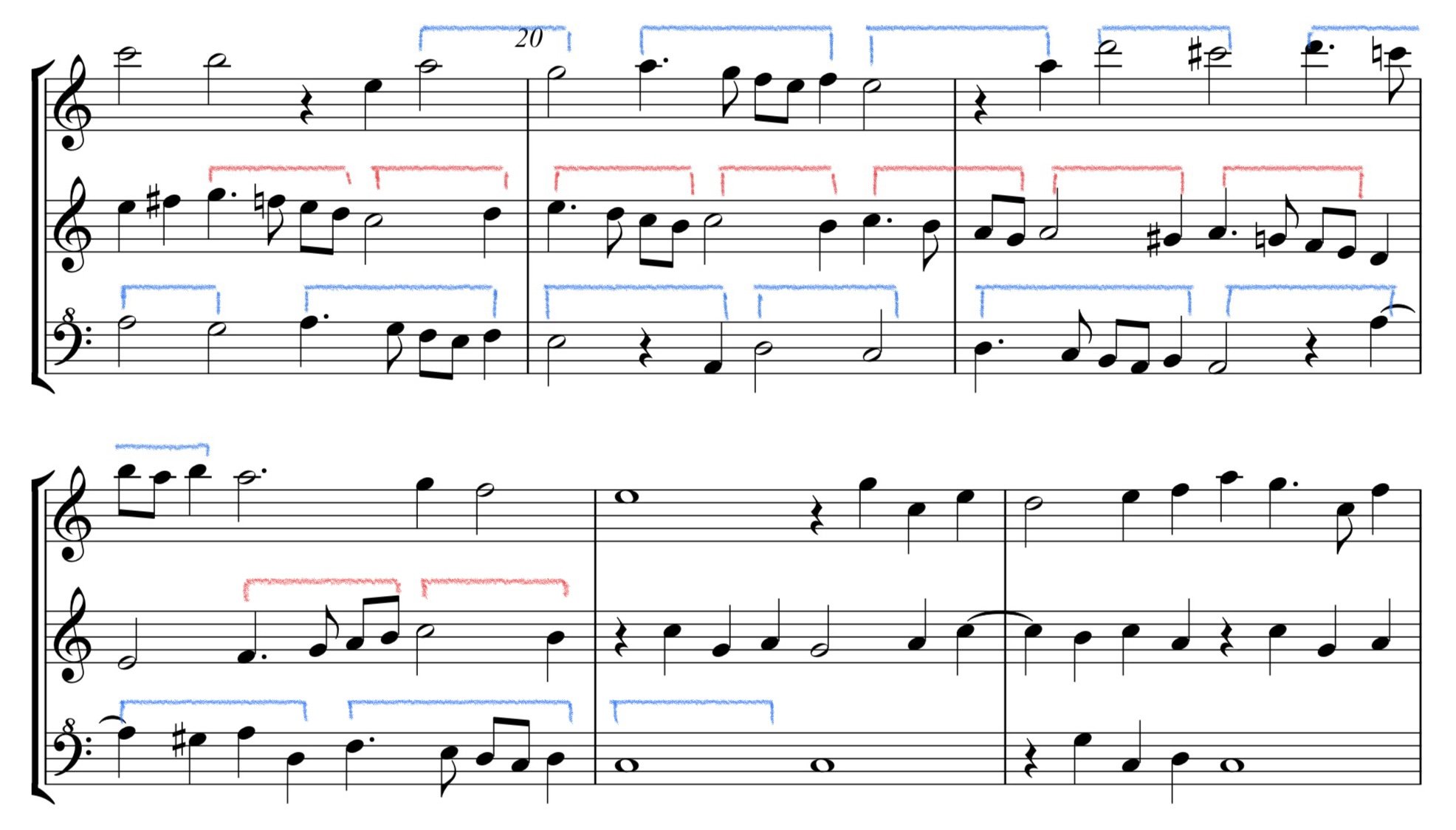When do you listen to music? Do you make time to sit down and give it your full attention, or are you a multitasker, enjoying music as an accompaniment while you do other things? I have a to confess I’m not very good at the latter approach - I tend to get distracted by the music, perpetually analysing what I’m hearing. But I do have one time each day when I can explore, and that’s when I’m at the gym or out for a brisk walk around our village.
This week I wandered the country lanes near home, listening to an eclectic mix of repertoire and I’m pleased to be able to share some of my discoveries with you in the latest of my Sounding Pipes playlist. I’ve dug out a varied selection of music, exploring the recorder’s rich repertoire. Some of the pieces are works you may have played yourself, but I hope you’ll discover some new repertoire here too.
Francesco Mancini - Sonata No.7 in C major
Mention the name Mancini to most people and they’ll probably think of Henry Mancini (composer of the Baby Elephant Walk and the Pink Panther theme) but his 18th century namesake is someone whose music every recorder player should explore. He was active as a teacher and composer in Naples, writing 29 operas plus a mixture of other vocal and instrumental work. His twelve recorder sonatas are beautiful works, composed so sympathetically for the instrument.
There are several recordings available of Mancini’s recorder sonatas, but this one captured my imagination with its fluidity and beautiful musical textures. Adding an archlute or theorbo to the continuo team is a stroke of genius and seems to make the music sparkle. Yi-Chang Liang is a beautiful player, adding his own exquisite ornamentation to enhance the melodic lines. I’d not come across him before, but he’s also a member of the Royal Wind Music and is evidently someone to watch.
If you don’t already know the Mancini recorder sonatas (and even if you do, for that matter!) I recommend exploring the whole of Yi-Chang Liang’s album as I’m sure you’ll find lots to inspire you. You can find a playlist containing all the tracks here.
Dick Koomans - The Jogger
Amsterdam Loeki Stardust Quartet - Pictured Air. Channel CCS8996
It’s almost thirty years since Dick Koomans composed The Jogger for the Amsterdam Loeki Stardust Quartet, and in that time it’s become a classic of the recorder quartet repertoire. I remember hearing them perform it in a recital at the Wigmore Hall as a teenager and I was blown away by the sheer energy of the music. This performance is quirky combination of live performance and pop video. We see Bertho Driver, one of the quartet members, frantically running through the streets, pulling a large case (presumably full of recorders) behind him as he dashes for the tram. You can sense his heart pounding through the music, ending with a flourish of Bach and a moment of total collapse.
Johann Heinrich Schmelzer - Sonata à 7
The Royal Wind Music - Alla dolce ombra’ Lindoro MPC0712
The Schmelzer Sonata is a rarity in the recorder consort repertoire - a piece originally composed specifically for recorder consort from the Baroque era. The instrument was a popular choice for solo and chamber music, but for some reason few composers of this period chose to write consort music. Of course, there’s lots of Baroque repertoire we can play if we don’t mind borrowing from other instruments, but there’s a satisfaction to be had from performing music composed with our instrument in mind.
This Sonata is always a popular choice with ensembles, although I’ve heard many a consort come to grief in the central section, with its unpredictable fugal entries. This performance, by The Royal Wind Music, is particularly lovely - played at both four foot and eight foot pitch, in a warm, resonant acoustic. If you’ve never played the Schmelzer yourself and this whets your appetite, I made a consort video of it back in August 2020 which you can find here, along with the music. You’re very welcome to round up six friends to join you, or just play along with me!
Michael Nyman - If from The Diary of Anne Frank
Echoing Voices - Andrea Ritter (recorders) & Daniel Koschitski (piano). ARS Produktion ARS38098
The diary written by Anne Frank during her time spent in hiding from Nazi persecution between 1942 and 1944 has inspired a vast number of films and documentaries, but until this week I hadn’t come across the animated film made in Japan in 1995. The music for it was composed by Michael Nyman, including this song, If, which has been recorded in countless different ways, both instrumental and vocal.
In this particular recording we hear Andrea Ritter playing the vocal line on the bass recorder, accompanied at the piano by Daniel Koschitzki, who you may also have come across as a recorder player in the Amsterdam Loeki Stardust Quartet. I defy you not to be moved by this heartbreakingly beautiful melody.
J.S. Bach Organ Sonata No.6 in G major, BWV530
Piracy: Baroque Music Stolen for the Recorder - Genevieve Lacey (recorders) & Linda Kent (harpsichord & chamber organ) ABC Classics 28948171293
Borrowing music from other instruments is something we do all the time to supplement the recorder’s repertoire and this particular piece is one I’ve played myself. Bach composed six organ sonatas in the late 1720s. Some of the movements are reworkings of earlier music (often taken from his many cantatas), but No.6 is the one work in the collection where he started completely afresh. In its original form, Bach writes three melodic lines - one for the organist’s right hand, the second for the left and the lowest voice for the pedals - and they’re all equally important. From that perspective they are ripe for transcription and this Sonata works particularly well when the right hand line is played on the recorder, leaving the keyboard player just two voices to cope with - quite enough for most mere mortals!
In this beautiful recording the Australian recorder player Genevieve Lacey pairs a tenor recorder with a Baroque chamber organ (played by Linda Kent) and this subtle pairing means it’s tricky at times to know where the voice of the recorder ends and the organ begins - they’re just perfectly matched.
J.S. Bach - Orchestral Suite No.3 - Ouverture
Orchestral Suites Nos.1-4: Ton Koopman & Amsterdam Baroque Orchestra Deutsche HM G010003033955W
While my Sounding Pipes playlists are always predominantly going to feature the recorder, sometimes I like to include other mediums, especially if there’s a connection to the other resources I share with you. My consort for this week was the Rondeau from Bach’s 2nd Orchestral Suite and in my accompanying Hints & Tips video I suggest you get into the habit of listening to good recordings of music to gain a better insight into the type of articulation and phrasing used for Baroque music. I couldn’t resist sharing such a recording here and I plumped for the Ouverture from Bach’s 3rd Orchestral Suite - my favourite of the four. This is one of Bach’s most extravagant pieces of orchestral music, featuring oboes, bassoon, trumpets and timpani alongside the strings, but the performance practices used are just the same as in the smaller scale music we play on the recorder.
While reading about the Suites I was interested to learn that Bach probably added the wind instruments later to enhance his string writing. When deciding which recording to share here I found I was too attached to the richer orchestral sound, but if you’re intrigued to hear Bach’s pared down original you can find it here, directed by Lars Ulrich Mortensen.
If you enjoyed playing the Rondeau I shared over on my Consorts page, you can listen to the original version for flute and strings here and, just for good measure, all four Orchestral Suites can be found here! You can never have too much Bach….
The Fool on the Hill
It’s become something of a tradition for me to share a more lighthearted piece in each of my Sounding Pipes playlists and this fun video by Tali Rubinstein immediately caught my attention when it was suggested to me by the YouTube algorithm. Long time readers will know I’m a fan of The Beatles, and Paul McCartney plays the recorder in their original version of this song. If you want a quirky fact to share with friends (who knows, it might come in handy in a pub quiz one day too…), he was taught to play the recorder by Margaret Asher, mother of actor Jane Asher, when he lodged with the family in the early 1960s. To this day he often uses the instrument in his solo albums.
Tali Rubinstein’s recording of The Fool on the Hill has clear echoes of The Beatles’ original, but she adds her own virtuosic flair, even sneaking in a snippet of Here Comes the Sun along the way. Whether this is your favourite sort of music or not, I defy you not to be smiling by the time you reach the end!
So there you have edition five of Sounding Pipes - hopefully you found some inspiration and entertainment along the way. If you’ve discovered some recorder shaped gems through your own musical explorations do share them in the comments below so we can all share the enjoyment!



